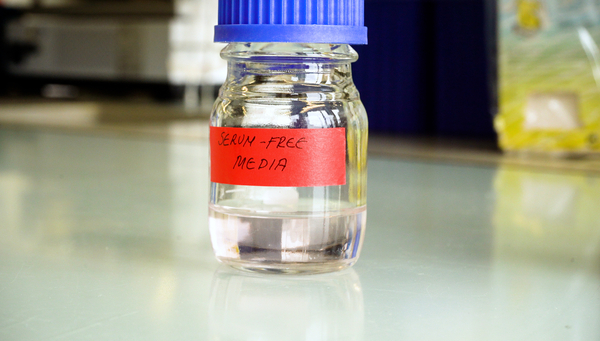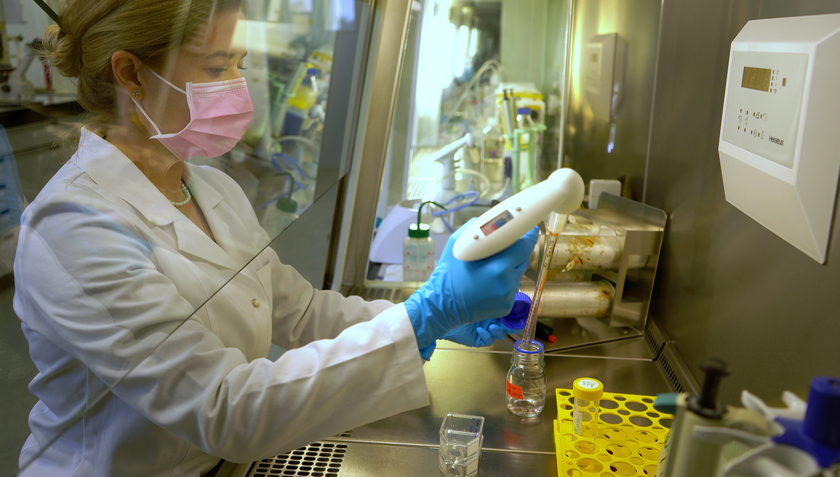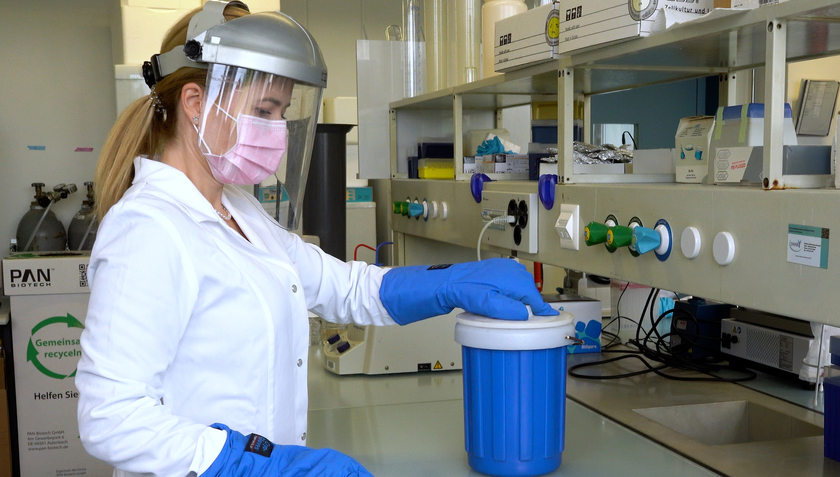News Detail
Changing the diet of cell cultures
August 19, 2025 |
‘A tremendously important topic of our research group is finding alternatives to animal testing,’ explains Kristin Schirmer, group leader at the department of Environmental Toxicology at the aquatic research institute Eawag. One such alternative is the use of gill cells instead of live fish in toxicology tests. However, the last hurdle to be overcome before these tests can be carried out completely without animal products in the future is the medium in which these cells have to be cultured. In cell culture research, foetal bovine serum (FBS) is considered the most widely used animal-derived additive to medium. It is a nutrient-rich mixture that, as the name suggests, comes from the blood of foetal calves. ‘The serum is obtained in an inhumane process,’ says Barbara Jozef, researcher at Eawag. It is therefore important to the researchers to avoid using it if possible. Various serum-free alternatives are already available on the market, but none of them can be used for fish cells.
A long road
Jozef began her search for a suitable alternative to fish cells by finding out what fish cells need to grow. To do this, she compiled all the studies on the needs of rainbow trout and other fish to lay the groundwork for initial tests. But there were too many parameters and nutrient combinations to test individually in an exclusion process. To speed up the analysis, Jozef developed a new method to quantify cell proliferation. The methodology became instrumental in further advancing Jozef’s research and contributed to an ETH Medal for one of her masters students and to her winning the Young Researcher Prize of the cosmetic company LUSH.
Once the Eawag researchers knew what the fish cells need and the FBS apparently provides, the next challenge was replacing FBS components with defined alternatives. The team carefully selected vitamins, minerals, hormones, growth factor and lipids to recreate the necessary growth conditions, minimizing animal-derived components wherever possible. The process was far from straightforward, requiring multiple iterations, constant adjustments and repeatedly led to unexpected setbacks. “If there’s one lesson that I take from this, it’s that true innovation in science rarely happens on a fixed timeline. Rather, the biggest breakthroughs come from allowing ourselves the time to question, to fail, and to push beyond our own expertise”, reflects Jozef.
Once the new medium was decided on, the acid test followed. “We accustomed the fish cells to the new medium by reducing the amount of FBS with each medium exchange until the cells could grow without it entirely”, she explains. But not all cells had this soft transfer. The other method used by Jozef and her team is called sink-or-swim. In this far more extreme test, the cells are transferred into the new medium without being accustomed to it. To the team's great joy, these cells also held up well. Nevertheless, she was able to observe differences. The cells that were slowly accustomed to the new medium took longer to adapt, but then grew faster after a few cell splits. By contrast, the sink-or-swim alternative grew quickly at the beginning, but then slowed down. But no matter which method is used, the new medium works!
Imitation encouraged
The medium not only works but Jozef and her team also demonstrated that these cells can be frozen in liquid nitrogen and revived if needed, an important factor in cell research. Jozef will now also test this new medium with the brain cells of rainbow trout. ‘Our research should encourage other researchers to try and adapt our process or medium for their own cell lines,’ she says. ‘This would be an important step towards animal-free research.’ She also hopes that industry will soon offer more replacement options of animal-derived components in media. ‘We can only test what is available on the market.’ With one exception, all components of the new medium are free of animal components. Only one protein is still of animal origin: since the fish cells reacted poorly to alternatives in tests, the new medium still contains small amounts of bovine serum albumin, since it is challenging for the cells to produce this protein themselves.
Industry as a beacon of hope
What is currently available on the market not only limits the possibilities in the laboratory, the new medium, which now anyone can prepare in their lab, also comes at a price: compared to foetal bovine serum, alternatives are still expensive. But presumably this will change too. Jozef has high hopes for reduced prices with increasing demand. In particular, research in the context of cultivated meat is a strong driver of new products coming onto the market that researchers could also draw on. Since the use of FBS is prohibited by the food industry, the cells of lab-grown meat must not be cultivated in such serum. The relevant companies are therefore investing heavily in the development of serum-free alternatives. And that this is possible is what Jozef, Schirmer and team have certainly shown.
Cover picture: The new medium does not require fetal bovine serum (Photo: Leonardo Biasio, Eawag).
Original publication
A systematic approach towards long-term, serum-free cultivation of fish cells with the RTgill-W1 cell line as example Barbara Jozef, Zhao Rui Zhang, Hans-Michael Kaltenbach, Kristin Schirmer



